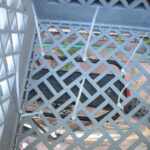Balance bike seat height is a key factor in determining if your child will have a positive and successful experience, and usabikers.net is here to help you get it right. Choosing the proper seat height ensures your child can comfortably walk, run, and glide, setting them up for cycling success. For parents seeking the perfect fit for their little riders, we’ll explore all the crucial aspects of balance bike sizing, including inseam measurements, ideal seat heights, and essential buying considerations.
If you’re ready to boost your kid’s motor skills, confidence, and coordination, keep reading to learn more about balance bike fit and features, and explore related topics like the four stages of learning to ride a balance bike, comparisons to training wheels, and in-depth reviews on our website like Strider Balance Bike Review, the ultimate resource for parents and kids alike.
1. Understanding Balance Bike Sizing
What Determines the Size of a Balance Bike?
The size of a balance bike is primarily determined by wheel size and seat height. These two features are essential for ensuring a good fit for toddlers and preschoolers of varying heights. Due to the significant height differences among young children, balance bikes come in a variety of sizes to accommodate different age ranges and inseam lengths.
Unlike regular bikes, there are no standardized sizes for balance bikes. Each model and manufacturer may have different dimensions, so it’s crucial to pay attention to specific measurements rather than relying on general size categories.
How Do Wheel Size and Seat Height Affect Sizing?
Wheel Size:
- The wheel size of a balance bike is measured by the inside diameter of the wheel, similar to regular bikes.
- However, unlike regular bikes, the wheel size of a balance bike is not always a reliable indicator of its overall size. For example, two bikes with 12-inch wheels may be designed to fit children of different ages due to variations in frame geometry and seat height adjustability.
Seat Height:
- Seat height is the most critical factor in determining the correct size of a balance bike for a child.
- The seat height should be adjusted so that the child can comfortably place their feet flat on the ground while sitting on the saddle, with a slight bend in their knees. This position allows the child to walk, run, and glide efficiently while maintaining balance.
Balance Bike Wheel Size vs. Seat Height
To illustrate the variations in sizing, let’s consider a few popular balance bike models and their respective wheel sizes and seat height ranges:
| Bike | Wheel Size | Seat Height Range |
|---|---|---|
| Woom 1 | 12″ | 10″ – 14″ |
| Strider Sport | 12″ | 11″ – 19″ |
| Guardian Balance Bike | 12″ | 12.5″ – 16″ |
| Strider 14x | 14″ | 15″ – 22″ |
| Bixe 16 | 16″ | 18″ – 22″ |
As you can see, bikes with the same wheel size can have very different seat height ranges, making it essential to consider both measurements when selecting a balance bike.
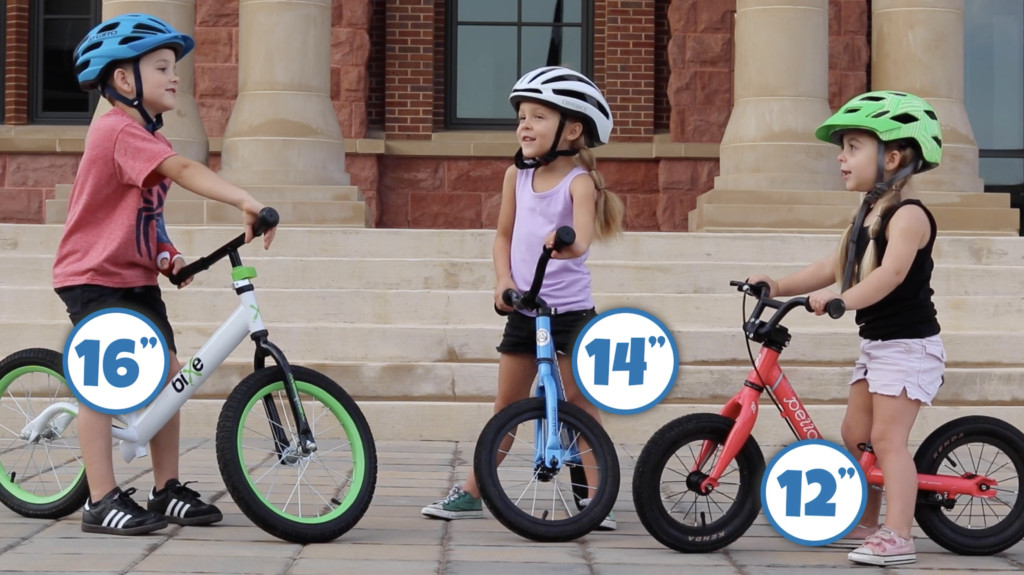 Three kids, each on a balance bike. One has 16 inch wheels, one has 14 inch wheels, and one has 12 inch wheels.
Three kids, each on a balance bike. One has 16 inch wheels, one has 14 inch wheels, and one has 12 inch wheels.
Why Seat Height is the Key to Balance Bike Sizing
The most important factor in determining the true size of a balance bike is its seat height range. When selecting the proper size balance bike for your child, you must first determine the seat height at which your child will ride the bike. This is accomplished by first measuring their inseam.
2. How to Measure Your Child’s Inseam for a Balance Bike
Step-by-Step Guide to Measuring Inseam
Measuring a child’s inseam is crucial for determining the correct seat height and ensuring a comfortable and safe riding experience. Here’s a step-by-step guide to measuring your child’s inseam using the “book and wall” method:
- Gather Your Supplies: You’ll need a book (a hardcover book works best), a wall, and a measuring tape or ruler.
- Prepare Your Child: Have your child wear shoes, as this will affect the measurement. Ask them to stand with their back against the wall, feet shoulder-width apart.
- Position the Book: Place the book between your child’s legs, with the spine facing up. Gently slide the book upward until it touches their crotch, mimicking the position of a bike saddle.
- Ensure Proper Alignment: Make sure the top edge of the book is parallel to the floor. This ensures an accurate measurement.
- Measure the Distance: Use the measuring tape or ruler to measure the distance from the top edge of the book to the floor. This measurement is your child’s inseam.
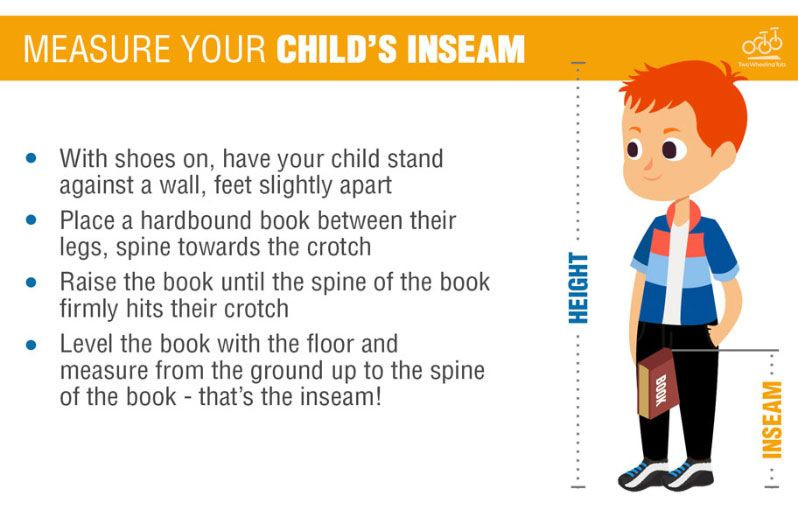 Infographic on how to measure your child's inseam for a balance bike
Infographic on how to measure your child's inseam for a balance bike
Tips for Accurate Measurement
- Make sure your child stands straight and still during the measurement.
- Use a thin book to minimize any additional height added by the book itself.
- Measure the inseam a few times to ensure consistency and accuracy.
Using Inseam Measurement to Determine Seat Height
Once you have your child’s inseam measurement, you can use it to determine the ideal seat height for their balance bike.
Calculating the Right Seat Height
- Optimal Seat Height: When sitting on the balance bike, a child should be able to place their feet fully on the ground with a slight bend in their knees. This position allows them to comfortably push off the ground to walk, run, and glide.
- Formula: To achieve this, the balance bike’s seat should be set 0.5″ to 1″ less than the child’s inseam. For example, if your child’s inseam is 13″, you should look for a bike with a minimum seat height no taller than 12.5″.
- Growth Room: It’s also important to consider room for growth. The maximum seat height of the balance bike should be at least 2″ above the child’s current inseam. So, for a child with a 13″ inseam, look for a bike with a maximum seat height of at least 15″.
Example: Child Inseam vs. Desired Seat Height Range
| Child’s Inseam | Desired Minimum Seat Height (-0.5″) | Desired Maximum Seat Height (+2″) |
|---|---|---|
| 11.5″ | No taller than 11″ | At least 13.5″ |
| 13.5″ | No taller than 13″ | At least 15.5″ |
| 17″ | No taller than 16.5″ | At least 19″ |
3. Fine-Tuning the Balance Bike Seat Position
Why is the Balance Bike Seat Position Important?
The balance bike seat position plays a crucial role in your child’s comfort, balance, and overall riding experience. Adjusting the seat to the correct height is essential for promoting efficient movement and preventing discomfort or injury.
Consequences of Incorrect Seat Height
- Seat Too Low: If the seat height is too low, the child will have too much bend in their knees. This can make running and gliding less natural and less efficient, as it restricts their range of motion and requires more effort to propel the bike forward.
- Seat Too High: If the seat height is too high, the child’s legs will be almost straight, or they will be on their tiptoes. This makes it difficult to run and gain momentum, which is necessary for balancing the bike. Additionally, it can be challenging for them to stop the bike safely, as they may not be able to reach the ground quickly and firmly.
Optimal Knee Bend
Adjusting the seat of the balance bike to approximately 0.5″ – 1″ below the child’s inseam will result in the optimal knee bend. This position allows the child to comfortably and efficiently propel the bike forward while maintaining balance and control.
4. Balance Bike Buying Guide: Key Features to Consider
Beyond Size: Essential Features for the Best Balance Bike
In addition to size, there are several other features worth considering before purchasing a balance bike. These features can significantly impact the bike’s performance, safety, and overall riding experience.
- Weight: The weight of the balance bike is a critical factor, especially for younger or smaller children. A heavy bike can be difficult to maneuver and may discourage the child from riding.
- Geometry: The geometry of the balance bike refers to the angles and measurements of its frame, which affect its handling and stability.
- Tire Type: Balance bikes come with either foam or air-filled tires. Each type offers different levels of cushioning, traction, and durability.
- Brakes: Some balance bikes come with hand brakes, which can help children learn to control their speed and stop safely.
- Turning Limiters: Turning limiters restrict the handlebar and front wheel from completing a full revolution, preventing sharp turns and potential accidents.
- Footrests: Footrests provide a place for children to rest their feet while gliding, but they are not always necessary and can sometimes interfere with the child’s stride.
- Bearings: The quality of the wheel bearings affects how smoothly the wheels spin. Sealed bearings offer better protection against dirt and moisture, resulting in a smoother ride.
- Frame Materials: Balance bike frames are made from various materials, including aluminum, steel, wood, and composite materials. Each material has its own advantages and disadvantages in terms of weight, durability, and cost.
- Hand Grips: Comfortable and secure hand grips are essential for maintaining control and preventing hand fatigue.
- Axle Bolts: The type of axle bolts used on the balance bike can affect safety and comfort. Low-profile bolts are less likely to scratch or injure the child’s legs.
Weight: Finding the Right Balance
How Much Should a Balance Bike Weigh?
As a general rule, you don’t want a bike to weigh more than 30% of your child’s weight. A 10-pound bike can be difficult for a 25 lb. 2-year-old to maneuver, but much easier for a 35 lb. 3.5-year-old.
The frame and wheels on the bike have the greatest effect on the bike’s overall weight. Air tires are much heavier than foam tires, which is why essentially all balance bikes sub-$150 that market themselves as “lightweight” have foam tires.
High-quality lightweight bikes that come fully loaded (air tires, handbrake, true headset, etc.), require specialty parts to keep the weight down. This quickly raises the cost of a bike. These specialty components are what differentiate the cost, quality, and performance of a $75 bike versus a $200 bike.
Weight of a Bike vs. Child
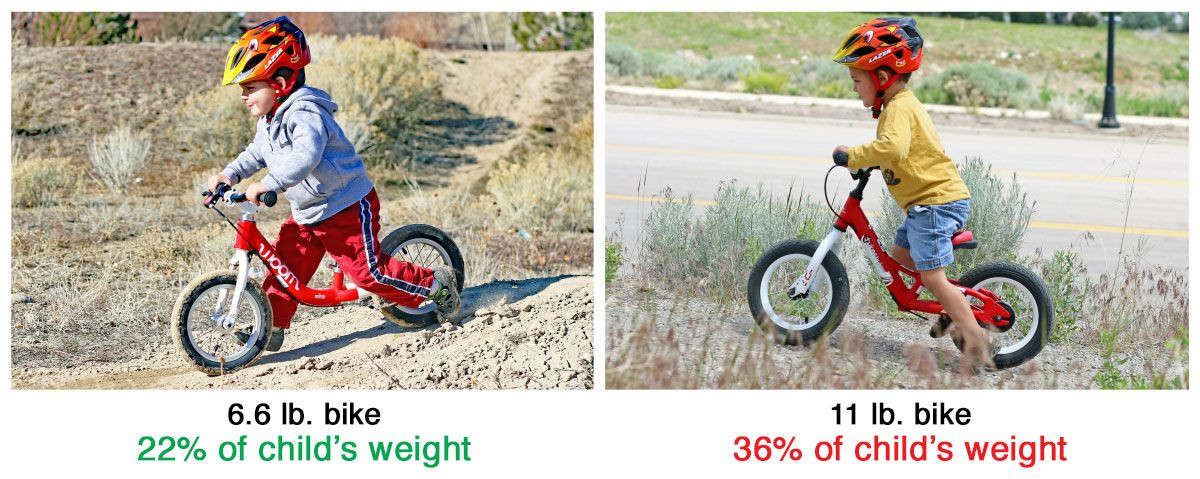 Child riding two balance bikes. One is only 6.6 lbs and is 22% of his weight. The other is 11 lbs and is 36% of his weight
Child riding two balance bikes. One is only 6.6 lbs and is 22% of his weight. The other is 11 lbs and is 36% of his weight
Foam Tires vs. Air Tires on a Balance Bike: What’s the Difference?
Tire Options for Balance Bikes
Tires play a key role in the performance and comfort level of a bike. There are two primary types of balance bike tires: foam and air.
Foam Tires:
- Foam tires are very common on balance bikes because they’re cheap to manufacture, lightweight, and are made of solid foam which can never go flat.
- For the average neighborhood rider who plans on sticking mainly to the pavement, foam tires are usually sufficient.
Air Tires:
- Air tires provide superior traction and cushioning compared to foam tires. Foam tires have very little give and do not dampen any bumps while riding.
- Air tires will flex when compressed so the child rider feels much less impact.
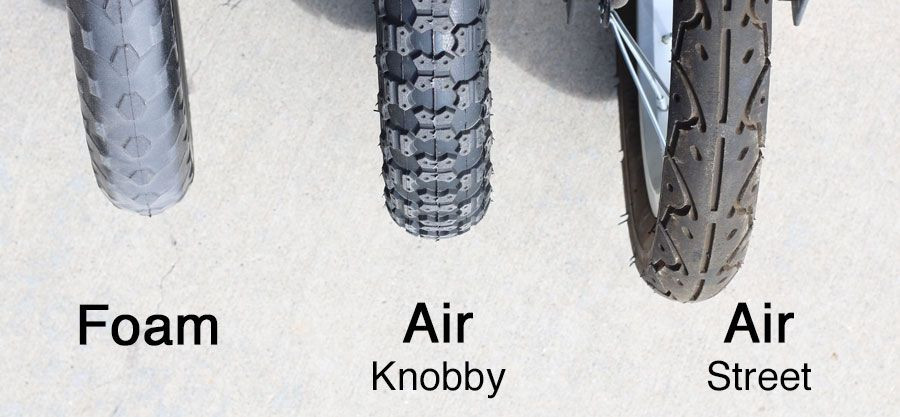 Three balance bike tires lined up next to each other – foam, knobby air, and street tread air.
Three balance bike tires lined up next to each other – foam, knobby air, and street tread air.
Air vs. Foam Balance Bike Tires
| Feature | Foam Tires | Air Tires |
|---|---|---|
| Puncture Proof | ✔️ | |
| Cushions Impact | ✔️ | |
| Superior Traction | ✔️ | |
| Easily Replaceable | ||
| All-terrain | ✔️ |
Does a Balance Bike Need Brakes?
The Importance of Hand Brakes
Kids will primarily use their feet to stop a balance bike, so hand brakes are optional. But when possible, we always recommend purchasing a bike with a hand brake. Why? Hand brakes can help prevent injury, save kids’ shoes, and better prepare a child to ride a pedal bike.
Usually between 2.5 and 3.5-years-old, most pre-schoolers have enough hand/eye coordination to use a hand brake. Once learned, kids tend to use their hand brake in conjunction with their feet for faster, safer stopping. Once mastered on a balance bike, they don’t need to relearn how to use a brake on a regular bike.
Braking with Feet vs. a Handbrake
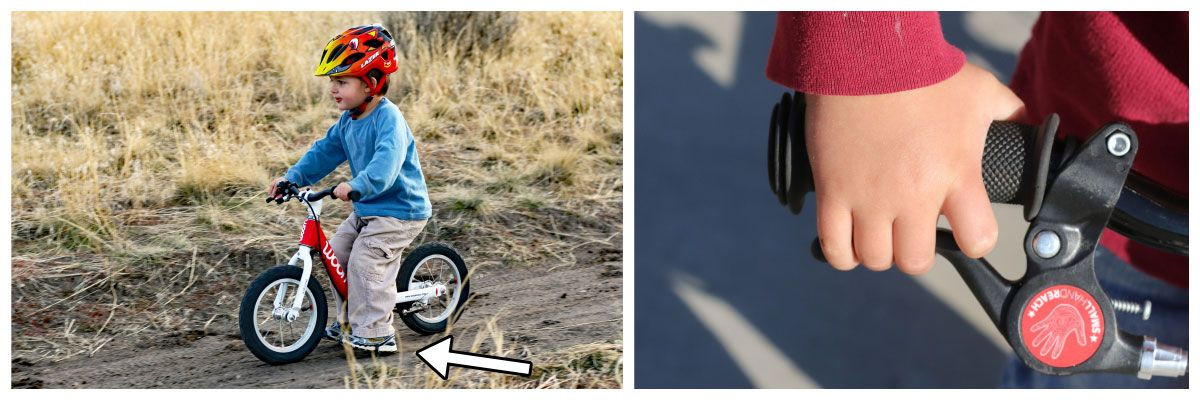 A child stopping a balance bike using his feet and then using a hand brake
A child stopping a balance bike using his feet and then using a hand brake
Balance Bike Geometry: How it Affects Performance
Understanding Geometry
The geometry of a balance bike makes a huge difference in how the bike performs. A bike with good geometry will work with the child to help them learn to balance and maneuver, while a bike with poor geometry will work against them. Determining whether a bike has “good geometry” is somewhat subjective, but by focusing on a few key elements of the bike you can get a good feel for its geometry.
Highlights of GOOD Geometry on a Balance Bike
So what exactly is geometry? Several factors work together to make up the geometry of a bike. (1) Frame design and wheelbase is paramount, followed by the (2) shape and size of the handlebars. The (3) position of the seat relative to the tires and the (4) angle of the front fork also play a role.
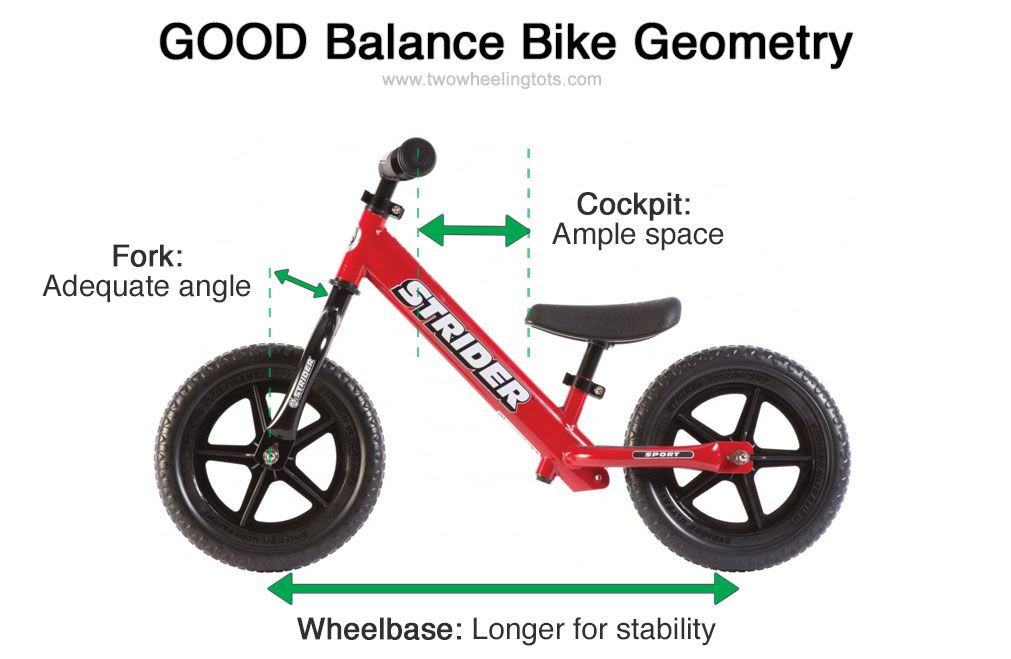 Diagram showing a balance bike with good geometry. Shows a longer wheelbase and ample space in the cockpit.
Diagram showing a balance bike with good geometry. Shows a longer wheelbase and ample space in the cockpit.
Turning Limiters: Pros and Cons
What is a Turning Limiter?
Turning limiters block the handlebar and front wheel from completing a full revolution. They are designed to prevent sharp turns and keep the brake cable from getting twisted. Proponents claim they help keep a child from jackknifing, while detractors claim they prevent kids from learning proper steering while they are young and still riding at slow speeds.
Elastic, Removable Limiter on the WOOM 1
While there are pros and cons to turning limiters, the overall effect most limiters have on riding is minor, and their presence shouldn’t be a determining factor in your purchase. Poorly designed limiters that greatly reduce the turning radius of the bike should be avoided, while the elastic limiter on the woom 1 is fantastic because it provides gentle correction and is removable.
Do You Need a Footrest on a Balance Bike?
Footrests: Necessary or Not?
The majority of balance bikes do not have footrests because they are not needed. When gliding on a balance bike, kids instinctively hold their feet up. In fact, in our nine years of testing bikes, we’ve never had a child ask where to put their feet! It’s always the parents that ask that question!
For some kids, footrests can be a crutch as they feel they have to use them and spend more time worrying about their feet than balancing and steering.
Unfortunately, poorly designed footrests are common and interfere with a child’s stride. These larger footrests can cause the rider to hit the back of their calf on the footrest when walking or running. Typically, a properly designed footrest is tucked back under the seat and out of the way of a child’s stride.
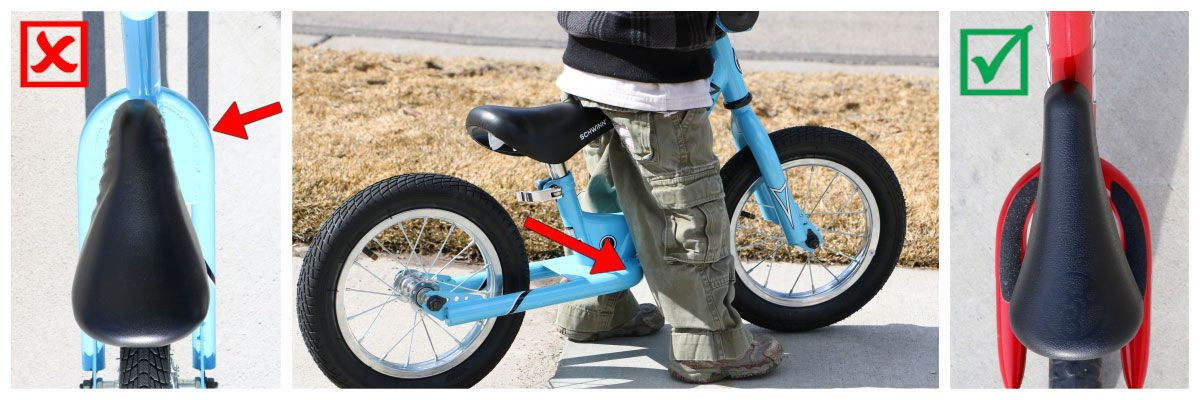 balance bike footrests design. Good and bad examples.
balance bike footrests design. Good and bad examples.
How Important are Wheel Bearings?
Understanding Wheel Bearings
The bearings of a bike determine how fast and how smoothly a tire spins around the axle. Sealed bearings have a rubber seal around them that prevents water, dirt, and dust from entering the bearings.
As a result, a bike with sealed bearings experiences less friction when spinning. Less friction means that your child will enjoy a smoother ride while exerting less effort on their balance bike.
Sealed bearings are considered to be a higher-end feature and result in a higher price tag. When choosing the features for your ideal balance bike, sealed bearings are a “nice-to-have,” rather than required.
Metal or Wood Balance Bike?
Frame Materials: A Detailed Look
Balance bike frames are made from aluminum, steel, wood, or composite material, with metal frames being the most common.
Metal:
- Metal bikes come in steel or aluminum alloys which play a contributing factor in the total weight and weight capacity of the bike.
- Aluminum alloy 6061 is lightweight, strong, rust-proof, and is used in higher-end bikes.
- Steel frames are common on less expensive models, but create a heavier bike and are prone to rust.
Wood:
- Wood bikes can be more environmentally friendly but are less adjustable than metal bikes.
- Higher-end wood frames can last for years if properly taken care of, while cheap, lower-end wood bikes tend to fall apart fairly quickly.
Composite:
- Composite frames are a glass fiber reinforced nylon composite found mainly on FirstBIKE.
- They offer a lightweight frame with a high weight capacity, without the concerns of rust or chipping paint.
Are Bike Grips Important?
The Role of Handlebar Grips
While seemingly minor, handlebar grips will most likely be one of the first safety features used on the balance bike. A rubber grip with a knobby end protects kids’ hands when the handlebars run into a wall, trees, etc., and also protects kids’ hands from hitting the ground during falls.
All balance bikes have grips and most have grips with protective bumpers. Because this is an easy and common way to keep your child safe, be cautious before buying any bike without protective bumpers.
WOOM’s Ergonomic and Protective Grips
 woom 1 balance bike grips
woom 1 balance bike grips
Why are the Type of Axle Bolts Important?
Axle Bolt Design
The front and rear axle bolts on balance bikes come in a wide variety of styles. These bolts can range from large traditional bolts to low profile bolts recessed into the frame of the bike.
With time, larger bolts that protrude out from the bike become scratched and dented. This can, in turn, lead to small legs getting scratched by the bolts.
To prevent this, some bikes come with plastic caps to cover the bolts, but many budget bikes do not. Higher-end bikes, like the woom 1, have flat or low profile bolts that are actually recessed in the fork to prevent any possible contact with little legs.
5. FAQ: Frequently Asked Questions About Balance Bike Seat Height
Q1: What is the ideal age range for a child to start using a balance bike?
The ideal age range for a child to start using a balance bike is typically between 18 months and 5 years old. However, this can vary depending on the child’s individual development and coordination skills.
Q2: How do I know if a balance bike is the right size for my child?
To determine if a balance bike is the right size for your child, measure their inseam and compare it to the bike’s seat height range. The seat should be adjusted so that the child can comfortably place their feet flat on the ground with a slight bend in their knees.
Q3: Can my child use a balance bike if they are already comfortable riding a tricycle or bicycle with training wheels?
Yes, a child who is already comfortable riding a tricycle or bicycle with training wheels can still benefit from using a balance bike. Balance bikes help children develop the necessary balance and coordination skills for riding a regular bicycle without training wheels.
Q4: What are the benefits of using a balance bike over a tricycle or bicycle with training wheels?
Balance bikes offer several advantages over tricycles and bicycles with training wheels. They help children develop balance, coordination, and steering skills more effectively, leading to a smoother and faster transition to riding a regular bicycle.
Q5: How do I adjust the seat height on a balance bike?
Most balance bikes have adjustable seat heights that can be easily adjusted using a quick-release lever or a wrench. Consult the manufacturer’s instructions for specific guidance on adjusting the seat height.
Q6: Is it better to have a balance bike with air-filled tires or foam tires?
Air-filled tires offer better cushioning and traction compared to foam tires, making them ideal for rougher terrains. However, foam tires are puncture-proof and require less maintenance, making them suitable for smooth surfaces.
Q7: Are hand brakes necessary on a balance bike?
Hand brakes are not essential on a balance bike, but they can help children learn to control their speed and stop safely. They also prepare children for using hand brakes on a regular bicycle.
Q8: What is the difference between a balance bike with a turning limiter and one without?
A balance bike with a turning limiter restricts the handlebar and front wheel from completing a full revolution, preventing sharp turns. Some parents prefer this feature for safety reasons, while others believe it can hinder the development of steering skills.
Q9: Can a balance bike be used on grass or other uneven surfaces?
Yes, a balance bike can be used on grass or other uneven surfaces, but air-filled tires are recommended for better traction and cushioning.
Q10: How long does it typically take for a child to learn to ride a regular bicycle after using a balance bike?
Children who have used a balance bike typically learn to ride a regular bicycle much faster than those who have not. Some children can transition to a regular bicycle in as little as a few hours or days.
Conclusion: Finding the Perfect Fit for Cycling Success
Selecting the right size balance bike for your child is essential for their comfort, safety, and success. By measuring their inseam and considering the seat height range, you can ensure a proper fit that allows them to walk, run, and glide with ease. Additionally, consider other important features such as weight, tire type, brakes, and geometry to find the best balance bike for your child’s needs and preferences.
Ready to find the perfect balance bike and get your child started on their cycling journey? Visit usabikers.net today to explore our comprehensive reviews, buying guides, and community forums. Connect with other parents, share your experiences, and discover valuable tips for teaching your child to ride. Together, let’s unlock a world of fun, adventure, and independence for your little biker!

